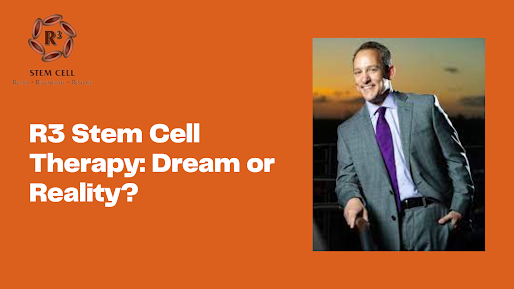R3 Stem Cell Therapy: Dream or Reality?
The discovery of cutting-edge regenerative medicine, like stem cell treatments, has allowed holding reasonable expectations for the future. Or is the science of stem cells too young to be a dream filled with many questions awaiting answers? This article will delve into patients' expectations from R3 Stem Cell and whether their dreams will ever become a reality.
What Are R3 Stem Cells?
R3 Stem Cell is an American healthcare organization founded by retired orthopedic Dr. David Greene. R3 offers stem cell and PRP therapies that harness the body's regenerative capabilities to bring hope.
Beyond the medical reach of today, treatments of tomorrow aim to treat the root cause of chronic degenerative diseases. Dr. David Greene's R3 stem cell treatment encompasses the convergence of rejuvenation, regeneration, and replacement.
Where Do They Originate?
Stem cells are often categorized into two broad sources:
a) Embryonic stem cells that are obtained from the embryo.
b) Adult stem cells obtained from fully differentiated tissue or organs.
Stem cells have the additional capacity to divide and differentiate into other tissues:
a) Totipotent Cells
b) Pluripotent Cells
c) Multipotent Cells
d) Unipotent Cells
Stem cells have been isolated from every tissue, with bone marrow and adipose tissue amongst the most common. Cells are generally removed from harvested tissue through a series of isolation steps.
How Are They Grown?
Stem cells are grown in plastic cultureware at a set number of cells per unit of surface area. Cells are grown in plastic cultureware at a set number of cells per unit of surface area. As cells begin to divide, they cover the surface area. As a result, these cells have a different appearance and lower capacity to mature into other cell types.
Should I Use Dr. David Green R3 Stem Cell?
Restoration of injured, diseased, or aged tissue through stem cell therapy continues to hold promise. Positive results from research and studies involving Adult Stem Cells (ASCs) support the potential role of stem cells in tissue restoration.
The potential use of differentiated Embryonic Stem Cells (ESCs) in stem cell transplantation medicine is still in its infancy. To ensure ESC can contribute to therapeutic approaches, it must follow the mentioned requirements:
First, large panels of cells suitable for grafting must be available.
Safety hazards need to be evaluated.
Finally, ESC must be available in the public domain without commercial restrictions.
David Greene, the retired orthopedic surgeon, believes that a healthy balance of optimism and skepticism in stem cell therapies can become a reality for optimum care.
Conclusion
The very first application of stem cells was to treat blood diseases. But unfortunately, hematopoietic stem cells (that turn into blood cells) are damaged during cancer treatment. Our human body relies on RBC, WBC, and platelets; losing hematopoietic stem cells can be risky.
In the case of stem cell transplant, doctors replace bone marrow with healthy stem cells from the patient. Adult Stem Cells (ASCs) are used to repair and regenerate tissues that have deteriorated due to chronic or acute injury or the natural aging process.
The discovery of stem cells for various treatments has been exciting. But unfortunately, misconceptions accompany any new advancement in science and medicine. Theories can only be solidified with time.



Comments
Post a Comment